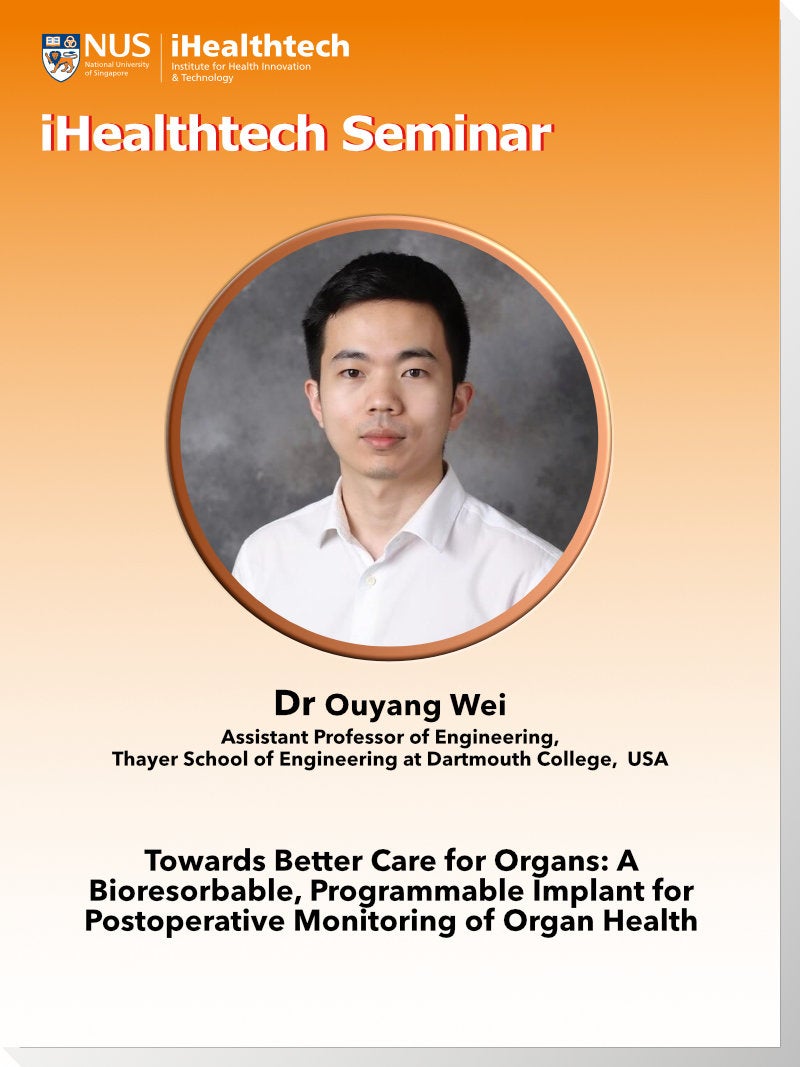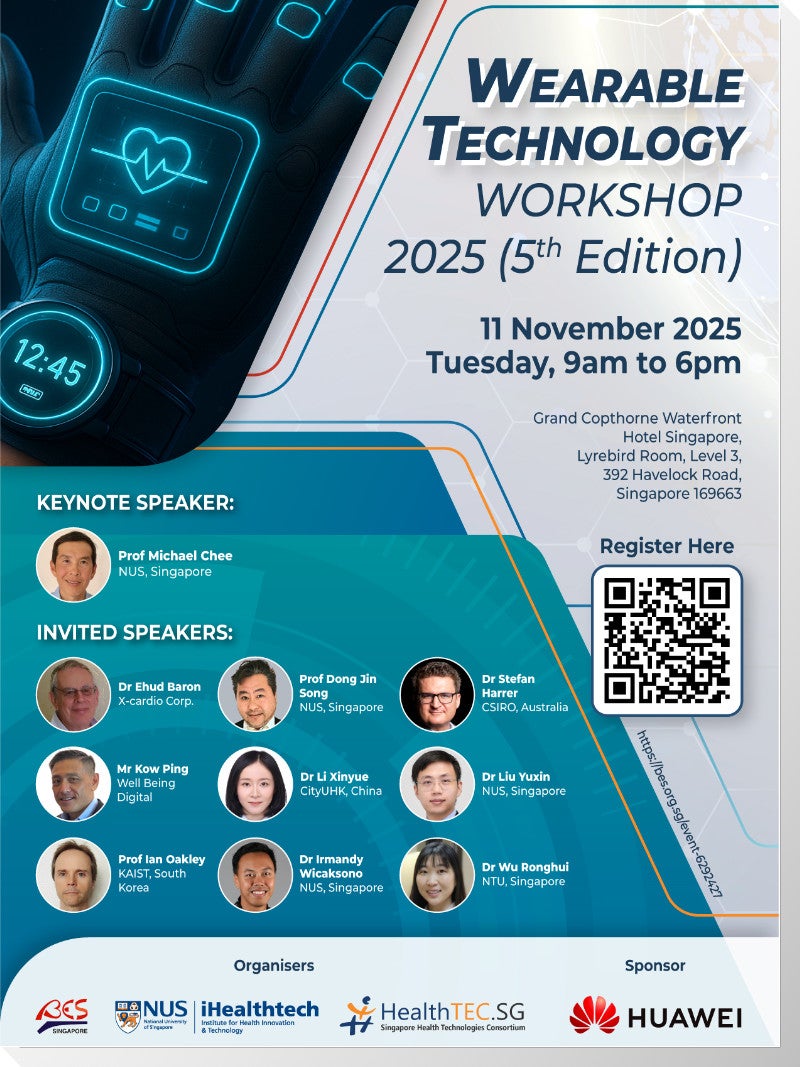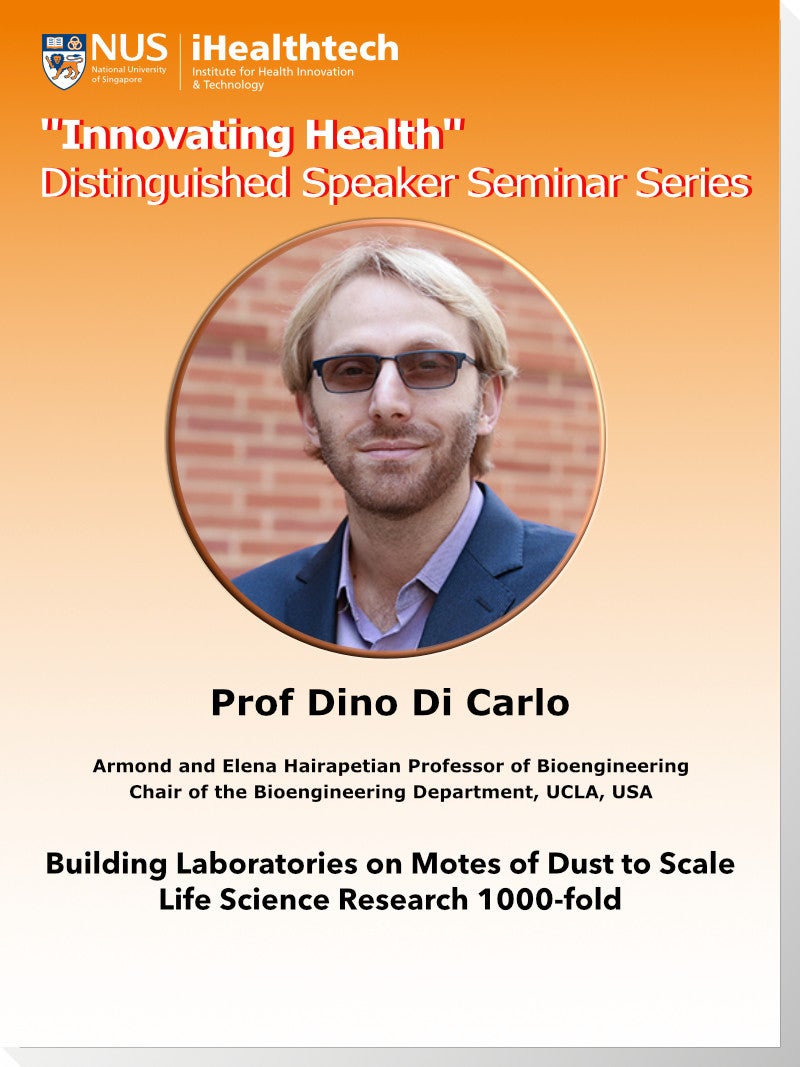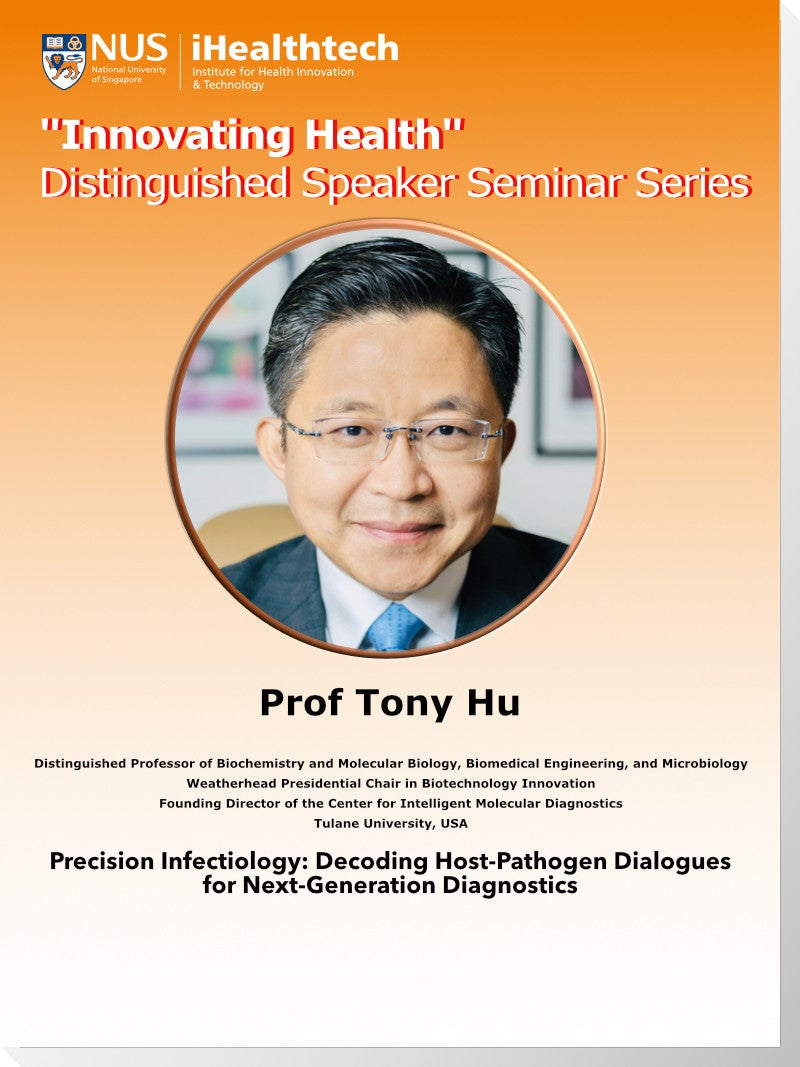Wearable Technology Workshop 2022
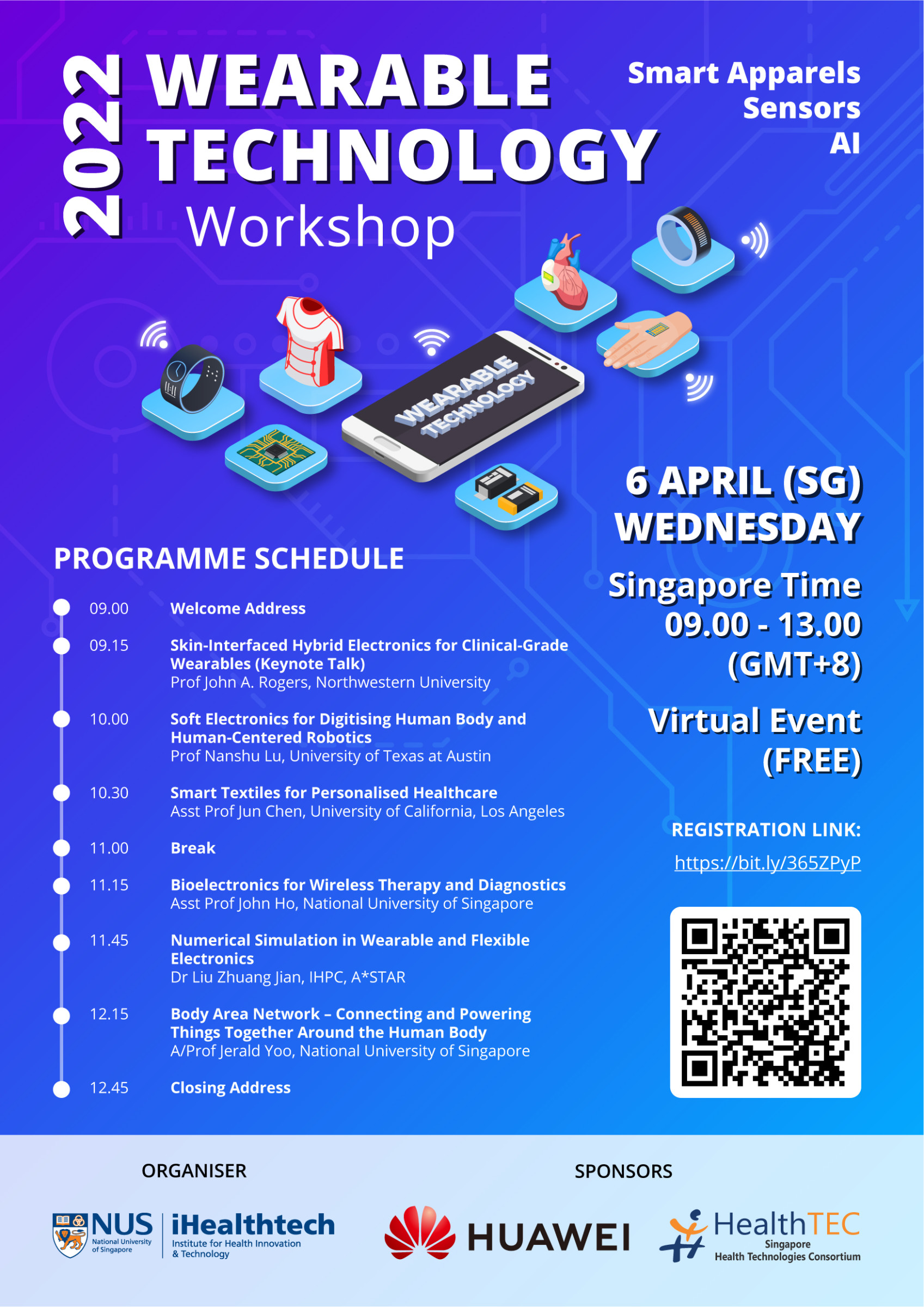
We are pleased to announce that the virtual WEARABLE TECHNOLOGY WORKSHOP 2022 will happen on Wednesday, 6 April.
Please join us in this exciting event that focuses on the latest wearable technology for health. This event is brought to you by NUS iHealthtech and HealthTEC, and sponsored by Huawei and HealthTEC.
Registration is now open. Please click HERE to register.
KEYNOTE TALK
Skin-Interfaced Hybrid Electronics for Clinical-Grade Wearables
Prof John A. ROGERS, Louis Simpson and Kimberly Querrey Professor of Materials Science and Engineering, Biomedical Engineering, Mechanical Engineering, Electrical Engineering and Computer Science, Chemistry and Neurological Surgery, Northwestern University
Abstract
Over the last decade, a convergence of new concepts in materials science, mechanical engineering, electrical engineering and advanced manufacturing has led to the emergence of diverse, novel classes of ‘biocompatible’ electronic and microfluidic systems with skin-like physical properties. These devices gently laminate onto the skin in a physically imperceptible fashion to produce continuous, clinical-grade measurements of biophysical and biochemical signatures of health status. This talk describes the key ideas and presents some of the most advanced devices, including (1) wireless electronic sensors for maternal, fetal, neonatal and pediatric health, with examples of scaled, active deployments in the most advanced hospitals in the US and across clinics in multiple countries in Africa and (2) microfluidic platforms that can capture, manipulate and perform biomarker analysis on microliter volumes of sweat, with applications in precise hydration management, screening for cystic fibrosis and nutritional status assessment.
Biography
Professor John A. Rogers obtained BA and BS degrees in chemistry and physics from the University of Texas, Austin, in 1989. He received SM degrees in physics and chemistry in 1992 and a PhD degree in physical chemistry in 1995 from MIT. From 1995 to 1997, Rogers was a Junior Fellow in the Harvard University Society of Fellows. He joined Bell Laboratories as a Member of Technical Staff in the Condensed Matter Physics Research Department in 1997 and served as Director of this department from the end of 2000 to 2002. He then spent thirteen years on the faculty at the University of Illinois, most recently as the Swanlund Chair Professor and Director of the Seitz Materials Research Laboratory. In the Fall of 2016, he joined Northwestern University as the Louis Simpson and Kimberly Querrey Professor of Materials Science and Engineering, Biomedical Engineering and Medicine, with affiliate appointments in Mechanical Engineering, Electrical and Computer Engineering and Chemistry, where he is also Director of the recently endowed Querrey-Simpson Institute for Bioelectronics. His research has been recognized by many awards, including a MacArthur Fellowship (2009), the Lemelson-MIT Prize (2011), the Smithsonian Award for American Ingenuity in the Physical Sciences (2013), the Benjamin Franklin Medal from the Franklin Institute (2019) and a Guggenheim Fellowship (2021). He is a member of the National Academy of Engineering, the National Academy of Sciences, the National Academy of Medicine, the National Academy of Inventors and the American Academy of Arts and Sciences.
INVITED TALKS
Industry 4.0, a.k.a. the cyber-physical systems, point to a future where humans will be more like robots (i.e., digital, computational, connected to the internet, etc.) whereas robots will be more like humans (i.e., soft, human-mimetic actuation and sensation, artificial intelligence, etc.). This talk will introduce my research on the mechanics, materials, bio-integration and functionality of soft electronics based on inorganic but high-performance functional materials such as metals, silicon, carbon nanotubes (CNT), and graphene. In particular, epidermal electronics, a.k.a. electronic tattoos (e-tattoos), represent a class of noninvasive stretchable circuits, sensors, and stimulators that are ultrathin, ultrasoft and skin-conformable. My group has invented a dry and freeform “cut-solder-paste” method for the rapid prototyping of multimodal, wireless, or very large area e-tattoos that are also high-performance and long-term wearable. The e-tattoos can be applied for physiological sensing for healthcare as well as human body digitization for human-robot interaction. While e-tattoos are to be worn by humans, e-skins are to be worn by robots. Recently, we have engineered an e-skin based on barely electrically conductive porous nanocomposite laminated with an ultrathin insulating layer. The hybrid piezoresistive and piezo-capacitive responses of this novel e-skin have enabled unprecedented pressure sensitivity at large pressures. It, therefore could be applied for sensing very subtle surface pulse waves from the temporal artery even under the pressure of a VR headset. A stretchable version of it could be much more sensitive to out-of-plane pressure than in-plane strain and hence can be mounted on an inflatable manipulator to perform diverse tasks. A perspective on future opportunities and challenges in this field will be offered at the end of the webinar.
Dr Nanshu Lu is currently Temple Foundation Endowed Associate Professor at the University of Texas at Austin. She received her B.Eng. from Tsinghua University, Beijing, PhD from Harvard University, and then Beckman Postdoctoral Fellowship at UIUC. Her research concerns the mechanics, materials, manufacture, and human/robot integration of soft electronics. She is currently an Associate Editor of Nano Letters and Journal of Applied Mechanics. She has been named 35 innovators under 35 by MIT Technology Review (TR 35) and iCANX/ACS Nano Inaugural Rising Star. She has received US NSF CAREER Award, US ONR and AFOSR Young Investigator Awards, 3M non-tenured faculty award, and the ASME Thomas J.R. Hughes Young Investigator Award. She has been selected as one of the five great innovators on campus and five world-changing women at the University of Texas at Austin. She is a highly cited researcher identified by Web of Science. For more information, please visit Dr Lu’s research group webpage at https://sites.utexas.edu/nanshulu/ and follow her Twitter: @nanshulu.
Assistant Professor Jun CHEN, University of California, Los Angeles
There is nothing more personal than healthcare Health care should move from its current reactive and disease-centric system to a personalized, predictive, preventative, and participatory model focusing on disease prevention and health promotion As the world marches into the era of the Internet of Things (IoT) and 5G wireless, technology renovation enables the industry to offer a more individually tailored approach to healthcare with better health outcomes, higher quality, and lower cost However, empowering the utility of IoT-enabled technologies for personalized health care is still significantly challenged by the shortage of cost-effective wearable biomedical devices to continuously provide real-time, patient-generated health data Textiles have been concomitant and played a vital role in the long history of human civilization The textile forms endow biomedical devices with biocompatible, biodegradable, even bioabsorbable features, allowing them to serve as on-body healthcare platforms with incomparable wearing comfort Merging biomedical devices and textiles becomes increasingly important owing to the growing trend of IoT In this talk, I will introduce our current research on smart textiles for biomedical monitoring, textile for therapy, and textile power generation as an energy solution for future wearable medical devices.
Biography
Dr Jun Chen is currently an assistant professor in the Department of Bioengineering at the University of California, Los Angeles His research focuses on nanotechnology and bioelectronics for energy, sensing, and therapeutic applications in the form of smart textiles, wearables, and body area networks He has published two books, 210 journal articles, with 120 of them being a corresponding author in Chemical Reviews, Chemical Society Reviews, Nature Materials, Nature Electronics, Nature Communications, Science Advances, Joule, Matter, and many others His works were selected as Research Highlights by Nature and Science seven times and covered by world mainstream media over 1,200 times in total, including NPR, ABC, NBC, Reuters, CNN, The Wall Street Journal, Scientific American, and Newsweek He also filed 14 US patents, including one licensed With a current h-index of 80, Dr Chen was identified to be one of theworld’ss most influential researchers in the field of Materials Science by the Web of Science Group Among his many accolades are the Materials Thought Leaders by Azom; 30 Life Sciences Leaders To Watch by Informa, UCLA Society of Hellman Fellows Award, Okawa Foundation Research Award, Materials Today Rising Star, Advanced Materials Rising Star, ACS Nano Rising Stars Lectureship Award, Chem. Soc Rev. Emerging Investigator Award, JMCA Emerging Investigator Award, Nanoscale Emerging Investigator Award, Frontiers in Chemistry Rising Stars, IAAM Scientist Medal, 2020 Altmetric Top 100, Top 10 Science Stories of 2020 by Ontario Science Centre, Highly Cited Researchers 2020/2019/2021 in Web of Science, etc Beyond research, he is an associate editor of Biosensors and Bioelectronics.
Bioelectronics for Wireless Therapy and Diagnostics
Assistant Professor John HO, iHealthtech, National University of Singapore
Abstract
Recent advances enable electrical and optical control of biological processes with exquisite spatiotemporal resolution. Implantable bioelectronic devices could translate these sophisticated capabilities into more precise therapies, but the long-term operation of such devices in the body remains a significant challenge. In this talk, we describe wireless technologies for powering bioelectronic devices deep within the body and achieving miniaturization at the scale of a single millimetre. We demonstrate applications of these technologies for potential treatments such as cardiac stimulation, optogenetics, and phototherapy.
Biography
John S. Ho is an assistant professor in the Department of Electrical and Computer Engineering at the National University of Singapore. He received his PhD in electrical engineering at Stanford University, where he developed a wireless power transfer technology that has been translated for clinic use in patient . He is a recipient of the NRF Fellowship and the Young Scientist Award and has appeared on the MIT TR35 Innovator Under 35 Asia and Forbes 30 Under 30 Asia list. His research focuses on developing medical devices that can wirelessly monitor and intervene wherever and whenever diseases occur in the body.
Numerical Simulation in Wearable and Flexible Electronics
Dr Zhuangjian LIU, Institute of High Performance Computing, A*STAR Research Entities
Abstract
The one of next-generation technology for electronics is wearable and flexible electronics systems. This type of electronics system should be sustained large deformations geometrically without causing failure in the materials and microstructures, in which it is constructed. There are wide applications of wearable and flexible electronics systems such as communicative packaging, flexible sensors, medical devices and soft robotics, which required flexibility and conformability at the system level.
Numerical modelling and simulation, which is based on computational mechanics studies, are powerful tools for understanding the performance and aided design of these systems. The modelling and simulation can be used to find the stress and strain in the devices under the usage conditions and to provide and establish design criteria. It is important to design this type of device without defect and failure during usage. Furthermore, the numerical simulations are useful to optimize mechanics and electronic performance through coupled multi-physical modelling and materials selection in the design of electronic circuits with maximum stretchability. The numerical modelling and simulations are used to investigate the mechanics and electronic performance of materials and structural systems for this type of electronic device, which has excellent bendability and stretchability. The high flexibility makes them very useful and advantageous for wearable devices with large strains. It is a potential way to make high-performance devices with significant-high stress or strain without failure during different applications.
Biography
Dr LIU, Zhuangjian works as a Senior Scientist at the Department of Mechanics Engineering, Institute of High Performance Computing, A*Star, Singapore. He received PhD and M.Eng. degrees from the National University of Singapore, Singapore; an M.Eng. degree from Tongji University, Shanghai, China; and a B.S. degree from Tianjin University, Tianjin, China. His research areas include solid mechanics, damage mechanics, computational solid mechanics, thin-film mechanics, soft matter and so on. Dr Liu has been a PI for numerous projects with government agencies and multinational companies. Currently, his research work focuses on computational nanoelectronics and nanomechanics, including instability and buckling analysis, wearable and flexible electronic systems and thermal analysis to the evaluation and improvement of the product’s design from the virtual simulation using high-performance computing. He has been identified as a 2018 and 2019 Highly Cited Researcher in Cross-Field by Clarivate Analytics.
Body Area Network – Connecting and Powering Things Together Around the Human Body
Assoc Prof Jerald YOO, National University of Singapore
Abstract
Body Area Network (BAN) is an attractive means for continuous and pervasive health monitoring, providing connectivity and power to the sensors around the human body. As the human body absorbs the majority of RF energy around the GHz band, existing RF radio may not be ideal for communications between and on-body sensors, and this is also true for wireless powering. To solve these issues, this talk presents the Body Coupled Communication (BCC)-based BAN. BCC BAN utilizes the human body itself as a communication medium, which has orders of magnitude less pathloss when compared to RF in the BAN environment. We will look into the channel characteristics followed by design considerations and transceiver implementation examples. Lastly, we will discuss the Body-Coupled Power Transfer and Energy Harvesting – using the same mechanism as BCC, we can power up the wearables throughout the body. We will conclude the talk with future aspects of BAN lying ahead.
Biography
Jerald Yoo received the B.S., M.S., and PhD degrees in the Department of Electrical Engineering from the Korea Advanced Institute of Science and Technology (KAIST), Daejeon, Korea, in 2002, 2007, and 2010, respectively. From 2010 to 2016, he was with the Department of Electrical Engineering and Computer Science, Masdar Institute, Abu Dhabi, United Arab Emirates, where he was an Associate Professor. From 2010 to 2011, he was also with the Microsystems Technology Laboratories (MTL), Massachusetts Institute of Technology (MIT) as a visiting scholar. Since 2017, he has been with the Department of Electrical and Computer Engineering, National University of Singapore, Singapore, where he is currently an Associate Professor. He has pioneered research on body-area-network (BAN) transceivers, wearable planar-fashionable circuit board, ASIC for piezoelectric Micromachined Ultrasonic Transducers (pMUT) and System-on-Chip (SoC) for wearable healthcare applications.
Dr Yoo served as a Distinguished Lecturer for IEEE Circuits and Systems Society (CASS) as well as for the IEEE Solid-State Circuits Society (SSCS) (2017-2018). He is the recipient or a co-recipient of several awards: the IEEE International Solid-State Circuit Conference (ISSCC) 2020 Demonstration Session Certificate of Recognition Award, the IEEE International Symposium on Circuits and Systems (ISCAS) 2015 Best Paper Award (BioCAS Track) and the IEEE Asian Solid-State Circuits Conference (A-SSCC) Outstanding Design Award (2005). Currently, he serves as the SSCS Singapore Chapter Chair as well as a Technical Program Committee Member of the IEEE ISSCC, ISSCC Student Research Preview (co-chair), IEEE Asian Solid-State Circuits Conference (A-SSCC, Emerging Technologies and Applications Subcommittee Chair), and IEEE Custom Integrated Circuits Conference (CICC, Emerging Technologies Subcommittee Chair). He is also an Analog Signal Processing Technical Committee Member of IEEE Circuits and Systems Society.


